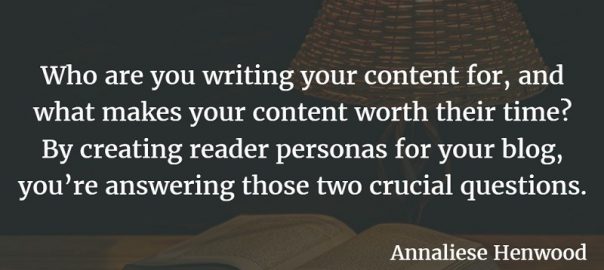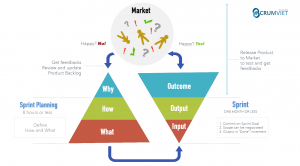— February 16, 2017
Who are you writing your content for, and what makes your content worth their time? By creating reader personas for your blog, you’re answering those two crucial questions.

This guide will lead you through the entire process of persona development, giving you the benefits and next steps as well. By the time you finish this article, you’ll be better prepared to create more targeted content with better results. You’ll have the knowledge you need to create your own blog’s reader personas, leading to a higher, more loyal, and better engaged audience.
— — —
What Is and Is Not a Reader Persona?
A reader persona is NOT:
A fictional character based on complete guesswork and assumptions.
A reader persona IS:
Created out of real data, values, needs, problems, and interests.
They are specific representations of your blog readership. Yes, creating reader personas requires some assumptions, but they should always be educated.
Why You Need to Have Reader Personas
Regardless of your writing talents or career influence, if you don’t know who you’re writing for, you’re not going to succeed – at least not to your full potential. Reader personas are essential to your content creation.
When you do the research and establish official personas, you’re better capable of creating content that attracts the right audience. The right audience is the one that helps you achieve your pre-established blog goals.
Benefits of creating reader personas
You’re no longer guessing. You’re no longer missing the mark. You’ll see a higher conversion rate. You’ll see a higher ROI from your blogging efforts.
These are just some of the key perks of creating personas for your readership. Think about what you hope to achieve from your blog. If you want to convert visitors into sales leads, you need to target your content to the people who would be interested in your products or services. To have a goal of more blog subscribers means you need to create content with topics that appeal to and inform people. Make them want to hear from you and see more by focusing your blogging efforts on what they could use.
Know your audience or risk wasting lots of time, effort, and resources.
Creating Reader Personas: The Data-Collection Process
When you think you’re ready to dive into creating reader personas, you should consider preparing a few things first:
- Do a complete blog audit to see where your content stands so far. I recommend this rather extensive checklist from Stacey Roberts via ProBlogger.
- Set up a spreadsheet or document for recording everything from this persona development process. I recommend using Google Sheets or Docs, especially if you’re working as a team, because it allows for easier collaboration and sharing. Alternatively, you can use HubSpot’s available template.
- Be ready to commit time to this. The more thorough you are, the more effective your personas will be. Depending on your blog’s current depth and goals, this process could take anywhere from an hour to a week to complete.
First, what are demographics?
Demographics are statistics that tell you more about who your audience is as an individual or group. They describe your readers, such as by age, gender, or location.
What count as demographics?
These are some but not all the data types that count:
- Age
- Gender
- Location
- Religion
- Job industry
- Job title
Why collect this data?
Even though demographic data is more generalized than what your end persona will be, you can use this information to inform you. Data about your current readership will give you a better understanding of where you are now so that you can make better decisions in the future.
Stick to 4-5 demographic points that will keep you focused when you proceed with the process. Too few or too many can slow you down.
How can I collect this data?
Google Display Planner is your best option because of its detailed results from your audience research. Google isn’t limited to certain social media platforms like some other tools are. It gives you extensive demographic data from website and search engine activity.
If you are focusing on a social media audience, you have options for more targeted tools. When pinpointing Twitter users, I recommend adding Demographics Pro to your Hootsuite account. It will give you data about your followers, other account followers, and any interest-based hashtag activity.
You can find more tools to consider in this article by Neil Patel via Quick Sprout. It gives you data collection tools for both demographics and psychographics. It’s a handy list for when you want to find the best tool for your needs.
You have your current demographic audience data, but what can you do with it? First and foremost, it’s time for your reality check.
Compare your data with who your ideal customer is. Do your readers share the same demographic data as your ideal customers? Do you see any discrepancies? Use this information to further understand where your efforts stand from a holistic business perspective.
Look at online reviews on your social media accounts and in 3rd-party stores, such as Amazon or an app store. See what people are criticizing you for. Look at your competitors’ reviews too to see what they’re neglecting. With this data, you can develop a content calendar that includes topics to help these reviewers resolve their issues.
Salesforce Canada created a handy infographic on why and how you can improve your content by researching your audience and their behavior. Some of the highlights from that infographic include:
- Research competitors’ content activity and popularity to see what you can do even better
- Don’t ignore your guest content and external media
- Look at your Google Analytics Behavior Flow report to see visitors’ path on your site
- Use Google Analytics to determine what content is most popular via pageviews and time on page
- Look at what keywords visitors are using to find your site to determine what they want to see
Google Analytics is a great tool to start with for finding information about reader behavior. You can see what content people are bouncing from versus sticking around. You can see what content is converting the most or any other goal you set up. Google Analytics also allows for reporting and monitoring via custom dashboards. When set up correctly, this tool can give you significant, extensive data about your blog’s success rate as well as your audience’s preferences.
Another way to see what content is gaining the most interest and attention is to use a heat map tool. It’ll show you how your readers are reading or interacting with your content. You’ll see what parts of your content are grabbing the most attention, which is key for determining future content structure.
Your sales team acquires a significant amount of data on their own that you should tap into for your own purposes. Sales staff have data on customer interests and what makes them tick. When talking with your sales team, ask them for any data that can help you create reader personas. Your customers are very likely also readers for your blog, so this is an opportunity you don’t want to pass up.
Another sales / marketing cooperation tactic would be to request sales to acquire more data from existing customers and even prospects currently in the final stages. A salesperson can interview customers for success stories and include questions about your blog content. The Inbound Marketing Methodology talks about delighting customers after the sale, so use this time to discover what content they want to see from you.
Your current blog subscribers and other readers are already interested in your contributions. Take advantage of this resource and tap into the available data. By asking your readers directly for their input, you succeed in acquiring data while also giving your audience power over the future of your content. Giving readers a say will help boost their loyalty, which is an extra bonus along with developing your personas.
You have several ways to gather data from your audience:
- Email your subscribers with an easy-to-complete questionnaire. Try using Google Forms.
- Reach out to your followers and fans on social media with a direct question or link to an external form. You can also try using Twitter polls.
- Set up in-person interviews with key audience members. Ask highly-targeted questions.
Regardless of your method, always offer an incentive to get people to participate and take the survey seriously. Do a raffle or offer a discount, for example.
When creating a survey, using Google, Survey Monkey, or another tool, make sure you make it a seamless process. Don’t require any more questions than necessary. Always make your questions clear to prevent confusion and inaccurate answers. Limit the number of open-ended questions by making most of the survey multiple choice with set answer options. All of this will help you gather the needed data from your current audience.
Your existing content can be a handy place to check for information. You can learn what topics are getting the most engagement or the most social shares. This gives you an idea of what topics are resonating with your current audience.
Look at your blog comments to see what readers liked or perhaps did not like about your articles. Check your social share counts for a better idea of what content people enjoyed enough to pass along. You might also want to check your Google Analytics data for:
- What social media content promotion is bringing in the most traffic
- What content has the lowest (or highest) bounce rate
- What readers are doing after landing on your blog
Your current content is a valuable source of inspiration for building your reader personas. You can use the research to better understand what future readers would like to see. Your reader personas are a combination of what’s ideal and what’s expected, and your established content will help you make educated decisions instead of guesses.
At this point, you have more than enough information to create effective reader personas for your blog. Your data is likely overwhelming because you collected everything possible. That’s why you have this last step. You need to bring your data down to a manageable level.
Start by going through what you have. Purge the findings you don’t need. This all depends on what you need for your persona development versus what might help. Stick to what you require first before going with the extras.
Focus on the data that’s most important to your blog goals. You want to create reader personas that help you achieve your goals, so it’s essential that you refine your findings based on that.
Creating Reader Personas: Applying the Data
Now that you have your reader persona data, how do you create a clear document with applicable information? It’s time to create official reader personas based on the data you collected.
For a quicker approach, download these persona templates from HubSpot instead of starting from scratch. There’s also this persona builder by Xtensio, which is a free online service.
What to Do with Your Reader Personas
Your reader personas are good to go, right? What do you do with them now?
Use your reader personas to enhance your content strategy. They can help you create more targeted content, and this will improve your content results. You’ll have a better chance of reaching your blog goals when you use reader personas to improve your future content creation.
Another key action to take with your personas is to share them with your sales team. Sales and marketing should always work together. Sharing your efforts with them will help them do their job, and it’s a good way to return the favor from when they helped you during persona development.
Lastly, make sure you keep your reader personas up-to-date. They’re never permanent. Instead, they are fluid and flexible as time goes on. Your readers will change and so will their preferences. Keep an eye on these changes as they arise, and update your personas accordingly.
Digital & Social Articles on Business 2 Community
(99)















